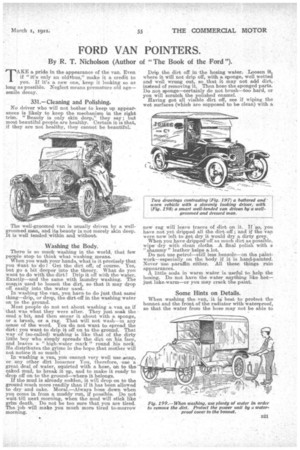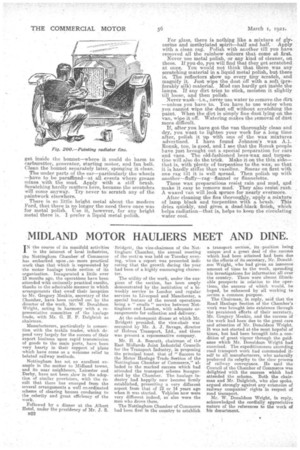• FORD VAN POINTERS.
Page 25

Page 26

If you've noticed an error in this article please click here to report it so we can fix it.
By R. T. Nicholson (Author of "The Book of the Ford ").
TAKE a pride in the appearance of the van. Even if "its only an oldsbus," make it a credit to you. If it's a new one, keep it looking so as long as possible. Neglect means premature old age—
senile decay.
33L—Cleaning and Polishing.
No driver who will not bother to keep up appearances is likely to keep the mechanism in the right trim. "Beauty is only skin deep," they say ; but most beautiful people are healthy. Certain it is that, if they are not healthy, they cannot be beautiful.
Washing the Body.
There is so much washing in the world, that few people stop to think what washing means.
When you wash your hands, what is it precisely that you Want to do ? Get the dirt off; of course. Yes, but go a bit deeper into the theory. What do you want to do with the dirt? Drip it off with the, water. Exactly—and the same with laundry washing. The soapiis used to looseia the dirt, so that it may drop off easily into the water used. In washing the Iran, you have to do just that sa,me thing—drip, or drop, the dirt off in the washing water on to the ground. Most people do not set about washing a van as if that was what they were after. They just soak the mud a bit, and then smear it about with a sponge, or a brush, or a rag. That will not wash—in any sense of the word. You do not want to spread the dirt: you want to drip it off an to the gruund. That way of (so-called) washing is like that of the dirty little boy who simply spreads the dirt on his, face, and leaves a, "high-water mark round his neck. He distributes the grime in the hope that mother will not notice it so much r In washing a van, you 'cannot very well use .soap, or any other dirt lo.osener You, therefore, use a great deal of water, squirted with a hose, on to the caked mud, to break it up, and to make. it ready to drop off on to the ground—where it belongs.
If the mud is already sodden, it will drop on to the ground much more readily than if it has been allowed to dry and cake. Moral.—Always hose down when you come in from a muddy run, if possible. Do, not wait. till next morning, when the mud will stick like grim death. Do not be too sure that you are tired. The lob will make you much 'moretired: to-morrow morning.
Drip the dirt off in the hosing water. Loosen it, where it will not drip off, with a sponge, well wetted and well wrung out, so that it may not add dirt, instead of removing it. Then hose the sponged parts. Do not sponge—certainly do not brush—too hard, or you will scratch the polished enamel.
Having got all visible dirt off, see if wiping the wet surfaces (which are supposed to be clean) with a
new rag will leave traces of dirt an it. If .so, you have not yet dripped all the dirt. off.; and if the van were now left to. get dry it would dry a dirty grey.
When you have drippe,d'off as much dirt as possible. wipedry with clean cloths. A .final polish with a "sliammy" leather helps a lot.
Do not use petrol—still less benzoic—on the paintwork—especially on the body if . it is hand-pamted. Never use para.ffin either. All these things ruin appearances.
A little soda in warm water, is useful to help the hosing. De not have the water anything like hot— just luke-warm—or you may crack the
Some Hints on Details.
When washing the van, it in best to protect the bonnet and the front of the radiator with waterproof, so that the water from the hose may not be able to
get inside the bonnet—where it could do harm to carburetter, generator, starting motor, and fan belt. Clean the bonnet separately. later, sponging it clean. The under parts of the car—particularly the wheels —have to be paraffined—at all events where grease mixes with the mud. Apply with a stiff brush. Scratching hardly matters here, because the scratches will come anyway. Try never to scratch any of the paintwork elsewhere.
There is so little bright metal about the modern Ford, that there is no longer the need there once was for metal polish. Use it, however, for any bright metal there is. prefer a liquid metal polish. For glass, there is nothing like a mixture of glycerine and methylated spirit—half and half, Apply with a clean rag. Polish with another till you have removed all the rainbow colours that come at first. Never use metal polish, or any kind of cleaner, on these. If you do, you will find that they get scratched at once. You would not think that there was any scratching material in a liquid metal polish, but there is. The reflectors show up every tiny scratch, and
magnify it. Just wipe the dust off with a soft (preferably silk) material. Mud can hardly get inside the lamps. If any dirt tries to stick,, moisten it slightly till loose, and then polish.
Never wash—i.e., never use water to remove the dirt —unless you have to. You have to use water when you cannot wipe the dust off without scratching the paint. When the dirt is simply fine dust lying on the van, wipe it off. Watering makes the removal of dust more difficult.
If, after you have got the van thoroughly clean and dry, you want to lighten your work for a long time after, polish it up with one of the wax mixtures advertised. I have found Johnson's , wax A.1. Ronuk, too, is good, and I see that the Ronuk people have just brought out a special preparation for ears and vans. The old-fashioned bees-wax and turpen tine will also do the trick. Make it on the thin side— that is, with plenty of turpentine to the wax so that
it is hardly. stiffer than va.seline. Smear on first with one rag till it is well spread. Then polish up with another—fluffy—rag—flannel or flannelette.
These wax preparations resist rain and mud, and make it easy to remove mud. They also resist rust:• A waxed van wiRlook spruce for nearly evermore.
After cleaning the fins thoroughly, apply a mixture' of lamp black and turpentine with a brush. This
dries quickly, -and gives a dead-black finish, which helps radiation—that is, helps to keep the circulating water cool.
































